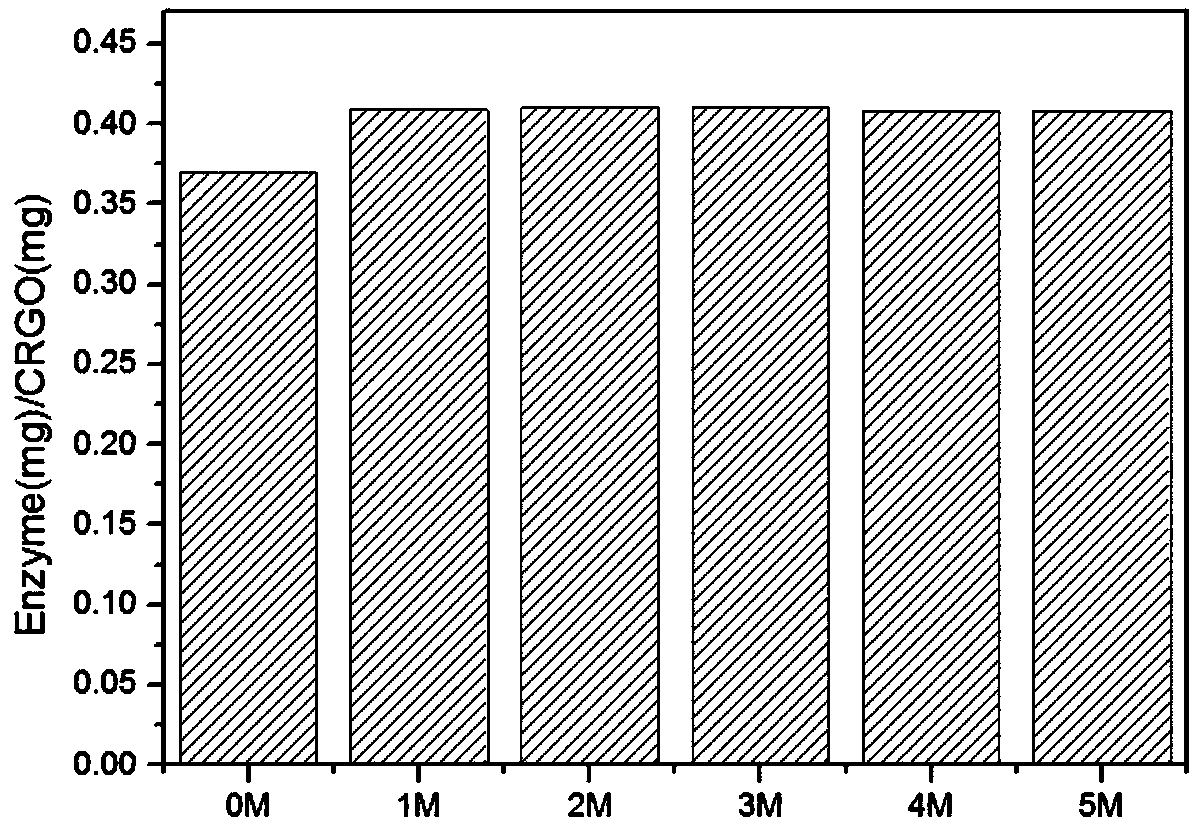Method for immobilization of phenylalanine dehydrogenase by chemical reduced graphene oxide
A technology of phenylalanine dehydrogenase and graphene, applied in the direction of oxidoreductase, microbial-based methods, biochemical equipment and methods, etc., to achieve the effect of maintaining enzyme activity, high immobilization rate, and enhancing effect
- Summary
- Abstract
- Description
- Claims
- Application Information
AI Technical Summary
Problems solved by technology
Method used
Image
Examples
Embodiment 1
[0031] (1) Preparation of crude enzyme solution:
[0032] Construction of a recombinant expression strain capable of expressing phenylalanine dehydrogenase with a His-tag tag: the original sequence of the phenylalanine dehydrogenase (PheDH) gene is from Bacillus nanhaiensis, as shown in SEQ ID NO.1; according to the above Original sequence, design primers as shown in SEQ ID NO.2 and SEQ ID NO.3, use PCR method to construct phenylalanine dehydrogenase with NdeI and Xhol restriction sites at the 5' end and 3' end respectively The gene and PCR synthesis process were completed by Shanghai Sangon Bioengineering Technology Service Co., Ltd. After the PCR amplified product was identified by 1% agarose gel electrophoresis, the PheDH gene fragment was recovered from the gel, and NdeI and XhoI enzymes were used to perform double digestion, and the digested product was recovered, and the same double-digested pET-28a plasmid (with with His-tag tag) for ligation, and the ligated plasmid w...
Embodiment 2
[0043] (1)-(4) The experimental procedures are as the steps (1)-(4) of Example 1.
[0044] (5) Preparation of reduced graphene oxide immobilized phenylalanine dehydrogenase: add the phenylalanine with His-tag label obtained in step (2) to the reduced graphene oxide suspension obtained in step (3) Pure enzyme solution of acid dehydrogenase, and make the final concentration of phenylalanine dehydrogenase with His-tag tag to 0.4116mg / mL, adjust the concentration of NaCl to 1M, shake in a constant temperature shaker at 4°C for 4h, and obtain immobilized Liase 1M-CRGO-PheDH, the recovery rate of enzyme activity can reach 42.15%. figure 2 shown. Reduced graphene oxide immobilized enzyme load capacity is 0.409mg / mg, as attached to the instructions image 3 shown.
[0045] (6) Determination of the temperature stability of the immobilized enzyme: keep the free enzyme and the immobilized enzyme 1M-CRGO-PheDH in a 40°C water bath for 3 hours, and measure the enzyme activity every 30 ...
Embodiment 3
[0047] (1)-(4) The experimental procedures are as the steps (1)-(4) of Example 1.
[0048] (5) Preparation of reduced graphene oxide immobilized phenylalanine dehydrogenase: add the phenylalanine with His-tag label obtained in step (2) to the reduced graphene oxide suspension obtained in step (3) Pure enzyme solution of acid dehydrogenase, and make the final concentration of phenylalanine dehydrogenase with His-tag tag to 0.4116mg / mL, adjust the NaCl concentration to 2M, oscillate in a constant temperature shaker at 4°C for 4h, and get immobilized Liase 2M-CRGO-PheDH, the recovery rate of enzyme activity can reach 46.44%. figure 2 shown. The load of reduced graphene oxide immobilized enzyme is 0.410mg / mg, as shown in the attached image 3 shown.
[0049] (6) Determination of the temperature stability of the immobilized enzyme: keep the free enzyme and the immobilized enzyme 2M-CRGO-PheDH in a 40°C water bath for 3 hours, and measure the enzyme activity every 30 minutes dur...
PUM
 Login to View More
Login to View More Abstract
Description
Claims
Application Information
 Login to View More
Login to View More - R&D
- Intellectual Property
- Life Sciences
- Materials
- Tech Scout
- Unparalleled Data Quality
- Higher Quality Content
- 60% Fewer Hallucinations
Browse by: Latest US Patents, China's latest patents, Technical Efficacy Thesaurus, Application Domain, Technology Topic, Popular Technical Reports.
© 2025 PatSnap. All rights reserved.Legal|Privacy policy|Modern Slavery Act Transparency Statement|Sitemap|About US| Contact US: help@patsnap.com



